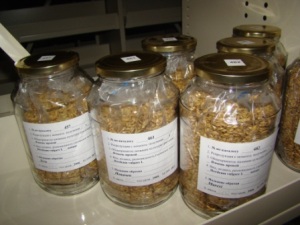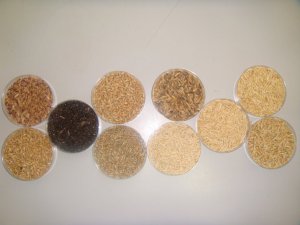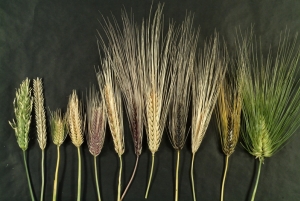Conservation of barley genetic resources
Contributors to this page: ICARDA, Syria (Ahmed Amri, Bilal Humeid, Kenneth Street, Natalya Rukhkyan, Jan Konopka, Siham Asaad, Adnan Omran and Fida Alô).
|
Diversity of Barley seeds and panicles  Barley seeds stored inside ziplock bags (for extra protection in case the jar is broken) in the active collection (photo: Bioversity/ILRI, by kind permission of Belarus genebank) |
Importance of barley conservation
The growing human population is expected to reach 9 billion by 2050. This will require a considerable increase of agricultural production in an increasingly unpredictable and changing climate. The conservation of the rich diversity of crop varieties and related wild species is essential for providing farmers and plant breeders with raw materials for improving and adapting the crops to meet environmental and climatic challenges and produce sufficient food in the future.
Barley germplasm collections include modern cultivars (currently in use), obsolete cultivars (often elite cultivars from the past and often found in pedigrees of modern cultivars), landraces, wild relatives (belonging to the genus Hordeum), genetic and cytogenetic stocks, as well as breeding lines.
Barley crop diversity (as is also the case for other crops) is gradually being lost due to the increasing influence of modern agriculture and rapid population dynamics and economical changes.
Major barley collections
In order to capture the existent crop diversity before it is lost forever, major cereal collections have significantly increased in recent years. It is estimated that there are nearly 400 000 accessions of barley globally under conservation (including genebanks, breeders and research collections).
Major collections (holding more than 10 000 accessions) are being conserved in Australia, Brazil, Canada, China (CAAS), Ethiopia, Germany (IPK), Japan, Mexico, Russian Federation, South Korea, Sweden, Syria (ICARDA), UK and USA (ARS). It is estimated that there are 47 major barley collections (with more than 500 accessions) and 26 minor collections worldwide. A larger proportion of accessions (nearly 60%) includes wild relatives and landraces, while the rest is a result of modern plant breeding and research.
References and further reading
Global Crop Diversity Trust. 2008. Global strategy for the ex situ conservation and use of barley germplasm [online]. Available from: http://www.croptrust.org/documents/web/Barley_Strategy_FINAL_27Oct08.pdf. Date accessed: 12 May 2009.
Comments
- No comments found







Leave your comments
Post comment as a guest